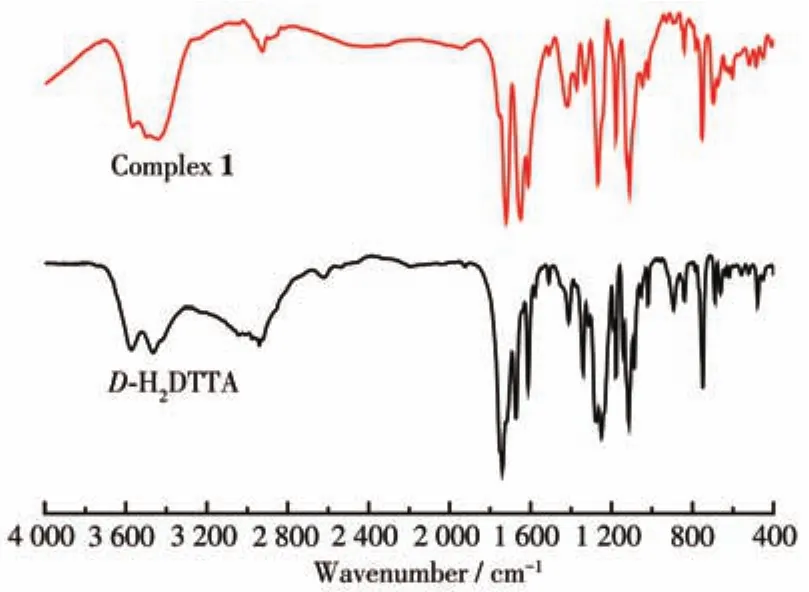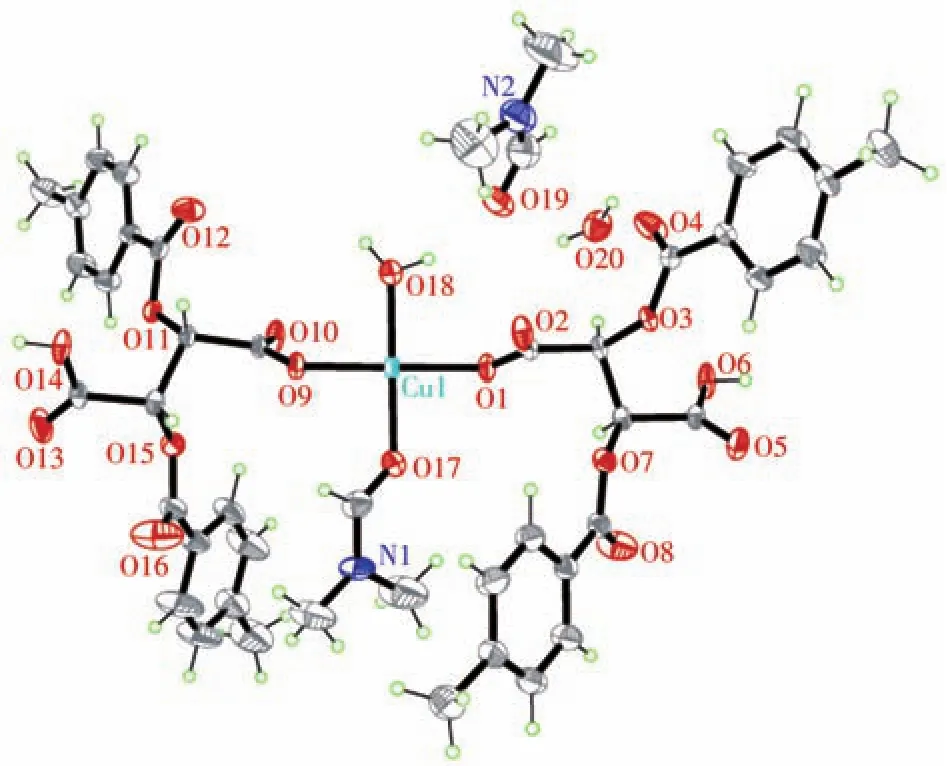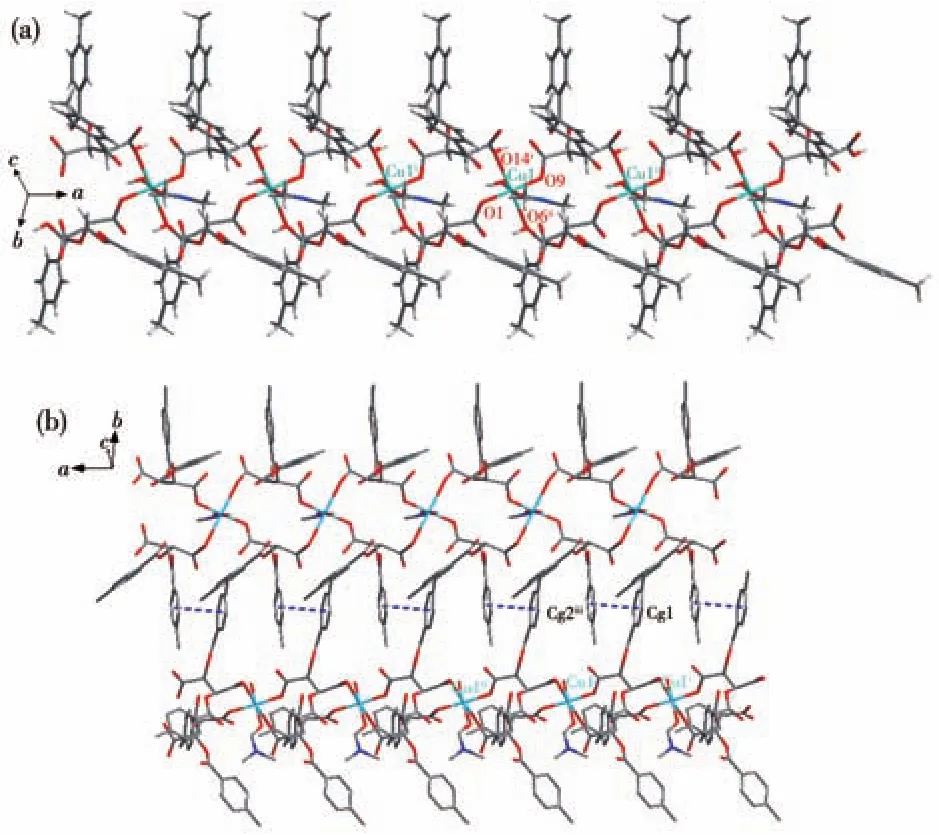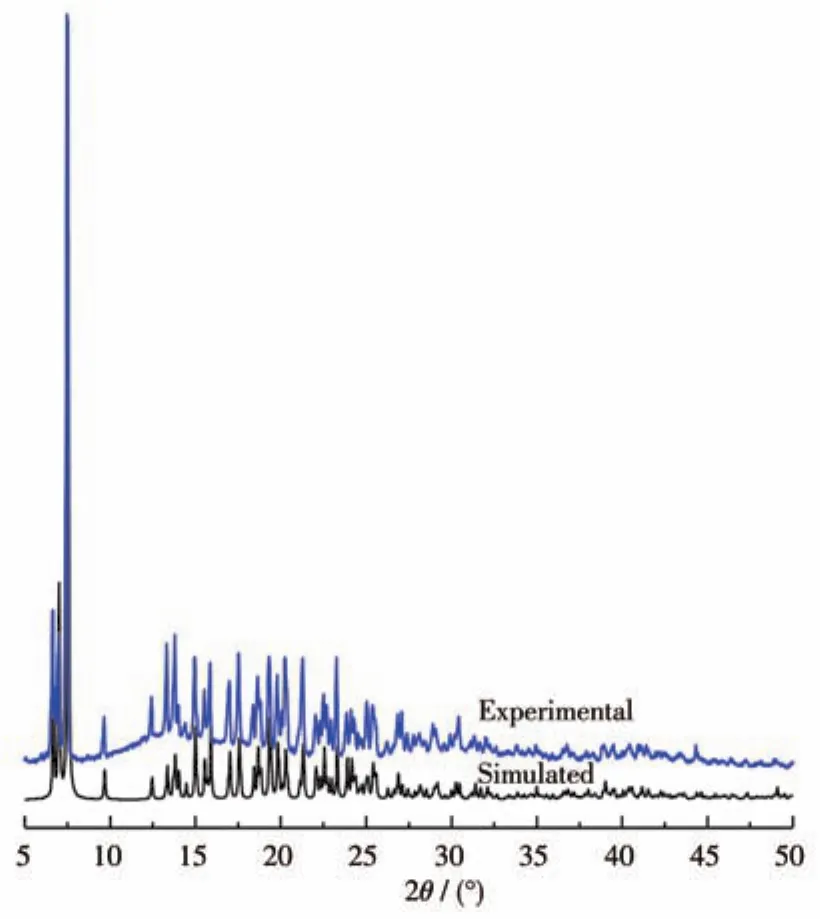Structure,Thermostability,Fluorescence,and Dye Adsorption Properties of a Copper(Ⅱ)Coordination Polymer Based on(+)-Di-p-toluoyl-D-tartaric Acid
2022-06-14ZHENGHuanCHUYanXiaoFENGSiSiYUANCaiXia
ZHENG Huan CHU Yan-Xiao FENG Si-Si YUAN Cai-Xia
(Institute of Molecular Science,Key Laboratory of Chemical Biology and Molecular Engineering of Ministry of Education,Shanxi University,Taiyuan 030006,China)
Abstract:A coordination polymer,formulated as{[Cu(HDTTA)2(DMF)(H2O)]·DMF·H2O}n(1)(D-H2DTTA=(+)-di-ptoluoyl-D-tartaric acid,DMF=N,N-dimethylformamide),has been synthesized.Its structure was characterized by IR spectrum,elemental analysis,X-ray single-crystal diffraction,and powder X-ray diffraction.Complex 1 features a 1D chain structure along the a-axis and forms a 2D layered structure in the ab plane through weak intermolecular interactions.The thermal decomposition process of 1 included the loss of solvent molecules below 197℃and followup decomposition of the main structure.Under the excitation of 300 nm,the fluorescence of the ligand was quenched by the coordinated Cu2+cation.In addition,complex 1 exhibited a good and specific adsorption effect on methylene blue dye in an aqueous solution with an adsorption rate of 81% after 49 min.CCDC:2122082.
Keywords:copper(Ⅱ)complex;(+)-di-p-toluoyl-D-tartaric acid;crystal structure;fluorescence;dye adsorption
0 Introduction
Coordination polymers(CPs)are structures connected by inorganic metal clusters or metal cations and organic ligands,with periodic coordination entities extending in 1D,2D,or 3D space[1].As a new kind of inorganic-organic hybrid material,CPs have a wide range of applications in adsorption and separation[2-4],catalysis[5,6],optical materials[7-8],and magnetism[9],etc.
In recent decades,organic dyes are widely used,not only in papermaking,textile printing,and dyeing but also in plastic and cosmetic industries[10-11].These industries produced a large amount of industrial wastewater in the production process and then discharged it into the natural water body,which poses a serious threat to the environment and human health[12-14].So environmental protection has become the focus of scientists all over the world[15].Common water treatment methods include biological treatment[15-16],membrane filtration[17-18],coagulation[19],ion exchange[20],and photocatalytic degradation[21-22],etc.However,these methods are costly and complicated and may produce toxic side effects.Adsorption,as one of the simplest,most effective,and most feasible methods,has been widely concerned in environmental water treatment in recent years[16-23].Nevertheless,finding effective,reusable,economically viable materials with high adsorption capacity remains a challenge[18].CPs,which exhibit high specific surface area,rich and diverse structures,adjustable pore sizes and shapes,and can interact with dye molecules through hydrogen bonding,electrostatic andπ-πinteractions,have been one of the ideal substitutes for the adsorption of organic dyes[24-26].
Now,it is still a challenge to accurately predict the structures of CPs[27],because the synthesis could be affected by many factors,such as metals,organic ligands,solvents,ratios of metal to ligand,temperature,and pH value[28-31].Among them,the selection of an appropriate organic ligand is one of the important factors in the synthesis of CPs.In this study,we focus on a tartaric acid derivative(+)-di-p-toluoyl-D-tartaric acid(D-H2DTTA)for the following reasons:(a)the carboxyl groups in the ligand can be completely or partially deprotonated to form different coordination patterns,which contributes to the formation of versatile CPs;(b)the aromatic groups containπelectrons,which is conducive to charge conduction and can help to obtain materials with good optical,electrical,and magnetic properties[32].
In this paper,the copper complex{[Cu(HDTTA)2(DMF)(H2O)]·DMF·H2O}n(1)(DMF=N,N-dimethylformamide)was successfully synthesized by solvent evaporation method with transition metal copper cation andD-H2DTTA.The structure of complex 1 was characterized by IR spectrum,elemental analysis(EA),X-ray single-crystal diffraction,and powder X-ray diffraction(PXRD).Moreover.thermostability,fluorescence,and dye adsorption properties of complex1were also studied.
1 Experimental
1.1 Materials and measurements
TheD-H2DTTA ligand was bought from TCI(Shanghai)Development Co.,Ltd.and used directly without further purification.All solvents and other reagents were of standard commercial grade and used directly without further purification.The sample for EA was dried under a vacuum and the test was performed with a CHN-O-Rapid instrument.IR spectra were obtained on KBr pellets with a BRUKER TENSOR27 spectrometer.PXRD patterns were collected on a Bruker D8 Advance X-ray diffractometer employing CuKαradiation(λ=0.154 18 nm)with a 2θrange of 5°-50°.The operating voltage and current were 40 kV and 25 mA,respectively.Thermogravimetric analysis(TGA)was performed on a Dupont thermal analyzer under a nitrogen atmosphere with a heating rate of 10℃·min-1.Fluorescence analyses were performed on a Fluoromax-4 spectrofluorometer with a xenon arc lamp as the light source.The UV-Vis spectra were obtained with a JASCO V-570 spectrophotometer.
1.2 Preparations of complex 1
As shown in Scheme 1,D-H2DTTA(1.25 mmol,0.483 0 g)was dissolved in a mixture of 10 mL DMF and 15 mL methanol,then 5 mL methanol solution of CuCl2·2H2O(0.65 mmol,0.110 8 g)was added.The mixture was stirred at room temperature for 10 min,then KOH solution(0.2 mol·L-1,5 mL)was added slowly.The mixture was stirred at room temperature for 8 h.After the mixture was filtered,the blue filtrate was placed in a 4℃refrigerator.Two weeks later,blue bulk single crystals of 1 suitable for the X-ray diffraction test were obtained with a yield of 35%.EA for C46H52N2O20Cu(%):C 54.36(Calcd.54.31);N 2.76(Calcd.2.68);H 5.16(Calcd.5.12).IR(KBr,cm-1):3 570w,2 938w,1 720s,1 653s,1 611s,1 509w,1 416m,1 372m,1 331m,1 267s,1 178s,1 112s,842w,753m,697m,603w,519w,486w,451w.

Scheme 1 Synthesis of complex 1
1.3 X-ray crystallography
X-ray single-crystal diffraction data for 1 were collected on a Bruker SMART APEXⅡ diffractometer with a CCD area detector and MoKαradiationλ=0.071 073 nm at 298(2)K.Multi-scan program SADABS was used for absorption correction[33].The structure was solved by the direct method and refined by the full-matrix least-squares method onF2using the SHELXTL-2014[34].All the non-hydrogen atoms were refined anisotropically.Hydrogen atoms attached to C atoms were placed geometrically and refined by using a riding model approximation,with C—H lengths of 0.093-0.098 nm.Hydrogen atoms in hydroxyl and water molecules were located from different Fourier maps and refined using their globalUisovalue with an O—H length of 0.082 nm.A summary of the crystallographic data and structure refinements for complex 1 is provided in Table 1.Selected bond lengths and angles for 1 are provided in Table 2.

Table 1 Crystal data and structure refinements for complex 1

Table 2 Selected bond lengths(nm)and angles(°)for 1
CCDC:2122082.
1.4 Dye adsorption
The dye adsorption ability of complex 1 was evaluated by the adsorption of three organic dyes including methyl orange(MO),rhodamine B(RhB),and methylene blue(MB)in an aqueous solution.At room temperature,1.5 mg complex 1 was added to 15 mL 0.03 mmol·L-1dye solution and mechanically stirred continuously.Then,the samples were periodically removed from the reactor and immediately centrifuged to separate any suspended solids.The transparent solution was transferred to a trace cuvette and analyzed by a UV-Vis spectrometer.
2 Results and discussion
2.1 IR spectra
IR spectra ofD-H2DTTA and complex 1 were examined at room temperature(Fig.1).The C=O stretching vibration characteristic absorption peaks at the positions of 1 739 and 1 672 cm-1forD-H2DTTA were shifted to 1 720 and 1 653 cm-1for complex 1,respectively[35].At the same time,the characteristic absorption peaks of C—O stretching vibration at 1 250 and 1 115 cm-1were shifted to 1 267 and 1 112 cm-1,respectively[36].The results prove that the carboxyl oxygen atoms in the ligand participate in the coordination to form the complex.

Fig.1 IR spectra of D-H2DTTA and complex 1
2.2 Crystal structure description
X-ray single-crystal diffraction shows that complex 1 belongs to the monoclinic crystal system and polarP21space group.As shown in Fig.2,the asymmetric structure of complex 1 contains a Cu2+ion,two HDTTA-ions,a coordinated water molecule,a coordinated DMF molecule,a free water molecule,and a free DMF molecule.The four oxygen atoms coordinated with Cu2+are from the carboxyl oxygen atoms of two HDTTA-ions,and the coordinated DMF and water molecules.The Cu—O bond lengths are in a range of 0.193 1(4)-0.195 0(3)nm,which is similar to those reported Cu2+CPs[37-38].Complex 1 forms a 1D chain structure(Fig.3a)along thea-axis with the distance between copper cations of 0.745 4(1)nm,andπ…πweak interaction between Cg1(the centroid of the C6—C11 ring)and Cg2(the centroid of the C26—C31 ring)helps complex 1 to form a 2D planar structure in theabplane.The distance between the rings is 0.379 4 nm(Fig.3b).

Fig.2 Structure of complex 1 with 30% thermal ellipsoid probability level

Fig.3 (a)One-dimensional chain-like structure of complex 1;(b)Weak π…π intermolecular interactions in complex 1
2.3 PXRD pattern and thermal analysis
To verify the phase purity of the complex,a PXRD analysis was performed.The experimental PXRD pattern was consistent with the calculated one based on the X-ray single-crystal data,certifying the high phase purity of the complex(Fig.4).In order to estimate the thermal stability of 1,TGA was performed in a range of 25-800℃(Fig.5).In the range of 51-80℃,complex 1 had a weight loss of 3.34%,equivalent to a solvent water molecule and a coordinated water molecule(Calcd.3.54%).Then the curve went through a plateau up to 157℃.In 157-197℃range,complex 1 lost 7.24% weight,equivalent to a solvent DMF molecule(Calcd.7.19%),and then,with heating temperature,the framework gradually broke down.

Fig.4 Simulated and experimental PXRD patterns of complex 1

Fig.5 TGA curve of complex 1
2.4 Fluorescence properties
The solid-state photoluminescent properties ofD-H2DTTA and complex 1 were investigated.Fig.6 shows that when the excitation wavelength was 300 nm,the ligandD-H2DTTA exhibitted strong emission peaks at 357 and 680 nm,which are eitherπ*-πorπ*-ntransitions of the ligand.Under the same conditions,no fluorescence emission peak was found for complex 1.Because Cu2+has the 3d9unsaturated electron configuration,there is electron transfer between Cu2+and ligand,leading to fluorescence quenching of the ligand[39-40].

Fig.6 Solid fluorescence emission spectra of D-H2DTTA and 1
2.5 Dyes adsorption
Three organic dyes,MB,RhB,and MO,were used as the model pollutant in aqueous media to evaluate the adsorption property of 1.The results showed that complex 1 displayed good specific adsorption ability to MB but little effect on MO and RhB under the same condition.As shown in Fig.7a,the variation of UV-Vis spectra of MB dye solution in the presence of 1 was measured at each 7 min interval.The spectra displayed that the characteristic absorption peak of MB at 665 nm decreased by 81% after 49 min,implying the significant dye removal behavior of 1 for MB from an aqueous solution.Fig.7b shows the variation of MB concentration(c/c0)with reaction time,wherec0is the initial concentration of the MB solution,andcis the concentration of the MB solution after the adsorption.Controlled experiments were also performed.Under the same experimental conditions,the concentration of MB remained essentially unchanged after 49 min without the addition of complex 1,implying that MB was relatively stable in the solution.

Fig.7 (a)UV-Vis spectra of organic dye MB solution in the presence of complex 1;(b)Adsorption rate of complex 1 to MB
The reaction suspension was centrifuged and the MB on the solid surface was washed away with water,and the resulting material was detected by IR(Fig.8).After adsorption,the C=O and C—O stretching vibration characteristic absorption peaks of complex 1 were maintained at the positions of 1 720,1 267,and 1 112 cm-1,respectively.The results show that the substance after adsorption is a mixture of MB and complex 1,which indicates that complex 1 is a good adsorbent for MB in this experiment.However,when complex 1 was added to the solution of MO and RhB,respectively,the characteristic strength peaks of the dyes had no obvious change(Fig.9).The difference in adsorption for these three dyes may result from the different sizes and shapes of the dyes.Compared to MO and MB,RhB is a triangular-planar structure and is difficult to be adsorbed by complex 1 due to the large size of RhB.Meanwhile,MB and MO with relatively small sizes.The planarity of MB is better than that of MO,which is in favor ofπ-π*stacking interactions between MB and the corresponding adsorbent.So,considering the structure of complex 1,the specific MB adsorption may be explained to proceed throughπ-π*stacking interactions between MB and the complex[41-42].

Fig.8 IR spectra of MB and complex 1 before and after the adsorption

Fig.9 UV-Vis spectra of organic dye(a)MO and(b)RhB solution in the presence of complex 1 within 49 min
Complex 1 could be recovered by the ultrasonic wave and washed with water and methanol.The recovered sample was used for the next cycle while all other reaction conditions remained unchanged.The performance of complex 1 adsorbed MB did not change significantly in four consecutive cycles,indicating that complex 1 has high stability and can be used for repeated treatment of MB dye(Fig.10a).PXRD patterns of the recovered sample were basically consistent with the simulated one,indicating that the skeleton of complex 1 has not collapsed after recycling(Fig.10b).
In order to exclude the influence of other dyes on complex 1,an anti-interference experiment was explored with MO and RhB dyes mixing with MB,respectively(Fig.11).The UV-Vis spectra showed that the MO and RhB dyes had little effect on the adsorption of complex 1 to MB,which proved that complex 1 had selective adsorption on MB.Based on the above experimental investigation,the results indicate that 1 can be used as the potential adsorbent for MB dye molecules.

Fig.11 UV-Vis spectra of(a)MO and MB,(b)RhB and MB solution in the presence of complex 1 within 49 min
3 Conclusions
We successfully synthesized a new coordination polymer 1 from CuCl2·2H2O andD-H2DTTA by solvent volatilization.The structure of complex 1 was determined by X-ray single-crystal diffraction,infrared,elemental analysis,and PXRD characterization.The thermal analysis experiment proved that the main structure of 1 could be maintained up to 197℃.The fluorescence analysis shows that the fluorescence quenching of complex 1 occurred compared to the ligand because of the introduction of copper cations.The adsorption experiments show that complex 1 has a good and specific adsorption effect on methylene blue dye and can be used as an adsorbent for methylene blue dye.
